ST. PAUL, MINN., — At Wills Wing’s 28th birthday celebration last month, pilots were able to fly their new curved tip competition glider. Unlike many earlier WW developments, this one isn’t a secret… to the contrary, they’ve showed it around at meets in the hands of WW team pilot, Paris Williams, who has been working with designer Steve Pearson to create it. Named the, uh… well, they haven’t named it yet, so it’s merely their new comp glider. • Referring to the new curved tips, WW isn’t sure a performance advantage exists but they say, "There seem to be some general differences in qualitative handling characteristics, though that area is largely a matter of personal pilot preference." • Unable to duck pilot interest in performance, Wills says that Williams’ experience in meets, "indicates that the performance gap between Manfred [Ruhmer’s] personal glider and our latest prototype is closing rapidly." The Pearson/Williams team has produced an amazing nine prototypes in four months.
Product Lines – April 00
ST. PAUL, MINN., — Late-breaking news includes the 2000 U.S. Nationals now being slated for Lakeview July 16-22. GW Meadows, the contest organizer, broke the news which was then confirmed from several sources. More news as it unfolds. Info: 252-480-3552. ••• It’s spring in America and all spotlights are turned on Florida where meets at Wallaby and Quest dominate the buzz. ••• Of late, reading Davis Straub’s Oz Report — which dwells heavily on competition — makes some enthusiasts wonder if Moyes sponsors the webzine (they don’t). The Lightspeed’s contest prowess has filled many online paragraphs. However, recent news of the Mexican Millennium Cup revealed Laminar started off 2000 well. Though neither was the winner, in both Mexican and earlier Australian Bogong Cup competitions we saw strong finishes by Wills’ Fusion and Aeros’ Stealth. Huh! Here in the new millennia, if one ignores rigid wings (sure!, just try), all we seem to hear about are Moyes, Icaro, Wills, Aeros (in no particular order, thank you).
Product Lines – March 03
St. Paul, Minn. — Welcome to a new era for your magazine. After two tests and two surveys of the membership, USHGA has launched its new combined magazine. s I touched on this last month as I congratulated Gil Dodgen for his 25 years of service. But the magazine you are holding is indeed the most significant physical product of USHGA. Hope you’re enjoying the new look. lll These magazine changes come amid another sweeping change in American light aircraft operation. FAA is expected to release its new Sport Pilot and Light Sport Aircraft rule in the summer or fall of 2003. Many European powered aircraft makers are paying very close attention to this development as they see a golden opportunity to enter the world’s largest aviation marketplace. True, hang gliders and paragliders are well protected from the heavy hand of the law by virtue of the USA’s simple Part 103 rule which will NOT change.
Product Lines – March 02
ST. PAUL, MINN. — FAA released the Notice of Proposed Rulemaking (NPRM) generally referred to as Sport Pilot. I won’t dwell on this as I’ve recently written about the new rule. But please watch Hang Gliding magazine and ask your USHGA leaders for advice on responding during the Comment Period — which is now open. lll Foreigners have done well at past U.S. Nationals. Now some Yankees turned it around. Congratulations to Mike Barber (Moyes Lightspeed 4) who came in first in the “Combined Open” category at the Australian Open in January. He finished second in “Class I Open” behind Ukrainian Oleg Bondarchuck (Aeros Combat 2). u Then, in the Australian Nationals, Paris Williams (Laminar St14) took the top spot in Class I. Davis Straub (ATOS 145) finished first in the “Overall” category. Good goin’ Yanks! lll Speaking of top Ukraine pilot Bondarchuck, U.S. importer, GW Meadows, writes, “With Oleg doing so well in the competitions in Australia, I’ve had lots of calls and e-mails from customers wanting the ‘low down’ on the new Combat 2.” Among changes from the earlier model, GW reports Combat 2 incorporates a slightly different sail cut, airfoil, span wise sail tension, and rib distribution.
Product Lines – March 01
ST. PAUL, MINN., — It’s history by the time you read this, but at the time of writing I was looking forward to seeing the Stalker in person at the Indianapolis Air Sports Expo, that gathering of sport aircraft of many types. The Aeros Stalker is a long time coming perhaps because it features numerous differences from other rigid wing designs. ••• Importer GW Meadows says Aeros has a full roster of competitive gliders for the new year, of which the Stalker is just one. He says, "The Stealth Combat is currently available in the 154 size, but a smaller size is currently being worked on at the factory." He believes that Combat is not only tops in performance, but is very user friendly as well. Aeros says the glider completed and passed the German hang glider certification tests. Combat uses 7075 springtip ribs, a Matrix top sail, in-flight self adjusting sprogs, and the Ukrainian producer says their reflex system supports more of the trailing edge of the glider.
Product Lines – March 00
ST. PAUL, MINN., — As a spring soaring season creeps ever closer, another new harness called the Tenax has been introduced by Woody Valley. Italian Ignazio Bernardi claimed the popular Euro harness had a 30% share of the pilots in the last World Meet in Monte Cucco. Woody Valley also has offerings for recreational pilots (the RS2), but the new Tenax is aimed precisely at the competition pilots who want the very least drag. Indeed, aerodynamics and ergonomics appear to be the push among all state-of-the-art harness makers. • Tenax features a "redesigned body shape" to improve comfort and drag reduction while also making entry easier. Tenax also has some internal pockets to help cleanliness but also has external access for two cameras, a radio, a drag ‘chute, and an emergency parachute. According to Bernardi, it is also "possible to install a ballistic parachute" (though this is not something with which U.S.
Product Lines – February 04
ST. PAUL, MINN. — More news seems to surround power and hang gliders or paragliders. Why? Well| first, it’s winter. Less flying occurs, at least in the northern latitudes. So pilots are talking about gear and powered harnesses and nanotrikes are part of the discussion. Secondly, expressions of interest by soaring pilots may be a result of USHGA gaining member approval for adding these machines to the mix (nanotrikes are not presently included; only foot launched aircraft). Add one more fact, the steadily-increasing age of HG&PG pilots, and no one should be surprised that discussion includes power (and wheels). With that in mind, I like to dispense with one item right now. Corrections Dept.: In August last year, I wrote about some spectacularly high flights accomplished by Minnesota pilots using powered harnesses for their initial launch into huge thermals. I also said, because that’s what I understood, that all four pilots reaching 10,000 feet AGL used NRG Mosquito harnesses sold by Bill Fifer of Traverse City Hang Gliders.
Product Lines – February 02
ST. PAUL, MINN. — As you read this, the 2002 Air Sports Expo is happening. Hope you made it. This event — a rare traveling indoor air show — has great potential for new enthusiasts to find hang gliding and paragliding, I believe. Of course, they may also find sailplanes, ultralights, aerobatic aircraft, R/C models, and more since the show features all these elements of sport aviation. u EAA has a magazine called “Sport Aviation.” Yet their coverage isn’t what we might call “sport aviation”(unless you consider homebuilding an aircraft a “sport”). Conversely, the Air Sports Expo features the kind of flying that’s done strictly for fun, for sport. Some of those EAA aircraft are 200-mph transportation alternatives. Building and flying them may also be for sport, but the aircraft themselves can serve a purpose of transport. Nothing wrong with that, but it isn’t what we do (nor is it what sailplanes, ultralights, aerobatic aircraft, or modelers do).
Product Lines – February 01
ST. PAUL, MINN., — Aeros is finally getting ready to show their new Stalker rigid wing entry after much design work and generating considerable market interest. U.S. Aeros, the Yankee distributor for the low-price producer, will show the Stalker at this month’s Air Sports Expo in Indianapolis, Indiana (7-10 Feb.). The show will present lots of aircraft from sailplanes to ultralights to aerobatic machines, plus RC models, powered parachutes, and, of course, hang gliders. Typically hang gliding enjoyed a good turnout at these events. • I believe the Air Sports Expo has the potential to be a powerful marketing tool for all the air sports and I encourage all midwest pilots to try to make the event. Contact fellow organizer, David Newill, at 317-873-2262 or go to www.soar-indy.dhs.org • If you attend you can examine the Aeros Stalker up close and personal. To date, only a private web site has let dealers (and the odd reporter) have a first glance.
Product Lines – February 00
ST. PAUL, MINN., — Bits and pieces are floating around in the aftermath of a new millennium and celebrations of grand style around the globe. It’s a good time of year to catch up on details before a new contest and soaring season begins. ••• Why did Aeros name their new rigid wing, "Stalker?" Aeros is the maker of the Stealth topless hang glider, which has achieved amazing U.S. market penetration. To explain the choice of names for their new rigid glider — which conjures a negative image for many Americans — Aeros identified "Roadside Picnic" as a popular novel with a mystical theme. In the book "Stalker" is the main character, idealized as "Neither hunter nor militarist, he’s just trying to survive, to understand, to learn… fearless and courageous, a pathfinder, an explorer, looking for happiness." OK, very positive and perhaps very appropriate for a new high-perf glider, but the name is still odd for American consumption.
Product Lines – January 04
ST. PAUL, MINN. — Happy New Year, glider fans. Once again a new year brings wintertime chills, at least for us northerners. So, this month I have some warm-up ideas to get you in the mood for a new soaring season. Mexican Flying Tours are in full swing for HGs and PGs. Cold weather flyers take note of temperatures in the 80s with plentiful thermals and authentic Mexican food. One outfit calls the experience a “Mextravaganza.” Super Fly Paragliding Mexico Tours 2004 treks to the famous Valle de Bravo site in central Mexico. At it for eight years, Super Fly takes you to fly three sites in seven days during January and February. PG gurus Jeffrey Farrell and Chris Santacroce are leading two tours in January and one in early February for pilots with P2 ratings or better and a minimum of 50 flight hours. They’ll handle the language, pickup and delivery from Mexico City airport, offer 5-star lodging in “a new, secure, classy, and clean hotel,” local club memberships, XC retreival in air conditioned vehicles, and in-flight coaching by radio.
Product Lines – January 02
ST. PAUL, MINN. — Welcome to a new year of soaring. While much of the country endures cold winter weather, spring thermals make for pleasant thoughts. ••• According to early reports, Moyes is preparing a new glider called the Litesport. Parlaying the popularity of their topless, high performance Litespeed, Moyes will reportedly build the new Litesport with a kingpost. Naturally it doesn’t offer the performance of their top-of-the-line model, however, Moyes competition star Gerolf Heinrichs is planning to compete on a Litesport in the (now summertime) Australian contests. At least he’ll fly one in the Australian Open, though observers say he’ll return to the Litespeed for the Aussie Nationals later in their season. Keep updated at MoyesAmerica.com where you can also find a detailed and well-presented tuning guide for the Litespeed. • An interesting sidebar to this story are numerous comments I heard at the October USHGA Board of Directors meeting where a surprising number of highly experienced pilots commented on their enjoyment of flying “simpler gliders,” like the Wills Eagle and Falcon.
Product Lines – January 01
ST. PAUL, MINN., — An interesting thing happened last fall. As 2000 came to a close, Italian flex-wing (Laminar) producer, Icaro, reached an accord with Germany’s top rigid wing (ATOS) producer, A.I.R. ••• Web writer, Davis Straub, reported in his Oz Report, "A.I.R. has moved its assembly operation and shipping to Icaro in Italy. Icaro has been a strong partner with A.I.R. from the start, producing parts and making sails, as well as being responsible for a significant portion of the distribution. Now it looks like Icaro is in a stronger position with respect to A.I.R." • Icaro confirmed Straub’s report saying, "In these past years, Icaro played already an important role at A.I.R. with producing the major part of the sails, the A-frames and the keels for the ATOS and, in addition, has sold over 130 of them." Icaro expressed, "Since the ATOS has been performing in such an incredible manner (present World and European Champions fly ATOS), we will not modify it for next year." • Straub, an outspoken supporter and user of rigid wings — such as in his notable record reported here in October — adds his personal feelings, "As a customer I feel more secure in having a larger and more diverse hang gliding company taking on more responsibilities for the ATOS.
Product Lines – January 00
ST. PAUL, MINN., — Welcome to a new era of hang gliding… well, and everything else, I guess. If you’re reading this, the Y2K bug evidently didn’t stop civilization as some feared. At least you got your Hang Gliding magazine. Is something more important than that? ••• As we start a new millennia, it pays to take stock of the state of the art. Topless flexwings are achieving great flights and cost Six Grand. Rigids wings seem to be the new darlings despite breaking the Ten Grand price barrier. We have carbon/kevlar helmets, highly sophisticated electronic navigation and flight performance instruments, and everybody flies with a parachute, sometimes two. Heck, we’ve even got luxury sport utility vehicles to haul it all around. Aren’t we something, cool 21st Century pilots? So I suppose it makes sense that lots of attention seems focused on the harness as we start a new year. It’s the new front line in the relentless drive for more performance.
AirSports Expo 2002

An example of a motorglider that may qualify under the FAA's proposed Sport Pilot rule is the lovely Lambada with its wonderful compound wings.

Ultralights to the right, sailplanes to the left and hang gliders dangling made for a lively display in the Ontario convention center.

Programs developed with the powerful computers at Silicon Graphics offered a real flying sensation as results were viewed on three large-screen televisions.

The sleek GD 808B motorglider has a fully retractable tractor-style powerplant.

AirSports Expo attracts a large crowd and many vendors. On the first day in Ontario, California, you could see this was going to be the largest AirSports Expo yet. In the shadow still lingering from September 11, many wondered and worried about participation and attendance, but the concern was baseless. A flurry of activity in the last few weeks before the show brought so many requests for exhibit space that the already designed floor plan had to be scrapped and redrawn. More than 2200 pilots and other visitors saw the exhibits of 65 vendors. While still small next to Sun ’n Fun or AirVenture Oshkosh, this was a good turnout. The range of vendors included many aircraft suppliers and all manner of accessories and informational products. Gathering of Eagles AirSports Expo represents the combined efforts of the Soaring Society of America (SSA), the U.S. Ultralight Association (USUA), and the U.S. Hang Gliding Association (USHGA).
Ultralight Motorgliders

A third-generation design from Noins Aeronautiques Alpaero, Exel is a sleek ultralight motorglider with a 45-foot cantilever wingspan.

A tiny single-cylinder engine has little exposure to the air, and Exel's fully folding prop further reduces drag.

Designed by Max Barel, the Graal is a multi-composite of molded wood and carbon fiber. It was successfully test-flown on January 4, 2004.
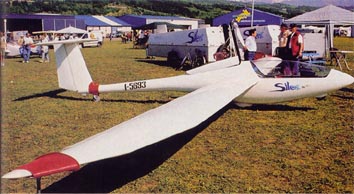
Some Americans have seen the Silent at airshows. Lucky them. This beautiful italian work of art is every bit as slick as a $150,000 motorglider, but it sells for only $32,000.

One reason for a one blade prop is that it fits into the Silent's compace interior.

Pilots will find plenty of goodies in the Motor Swift. Phone, GPS, radio and variometer/altimiter/barograph line the eyebrow level. Handles or levers control flaps, trip, throttle, joy-stick and the rocket parachute.

The flying-wing Motor Swift is a California design built in the U.S. for some years before Belgium-based Aeriane bought the rights to manufacture it for the European market.

The ultralight motorglider evolution continues in Europe. Ultralight motorgliders are as rare as hen’s teeth in the U.S., but Europe is blessed with several choices that nicely complement high-end, high-priced full-size motorgliders. While America has the lovely Esprit from Aero Dovron, our soaring friends across the Atlantic continue to lead this specialized market. Full-size (higher-weight) motorgliders start at more than $100,000 and can surpass $200,000. Those who can afford them are surely thrilled with such beautiful machines, but most of us can’t spend that kind of money regardless of their superb performance. However, at $20-$30,000 ready-to-fly, a clean self-launching soaring aircraft is more affordable. Like their larger siblings, these efficient designs can also cruise under power respectably well, giving them broader appeal than pure gliders. Noins’ Excel One of the newest of the breed is the Excel from France’s Noins Aeronautiques Alpaero. Based in beautiful Tallard in the French Alps, Noins is revered by French soaring pilots.
Czech Aircraft Works
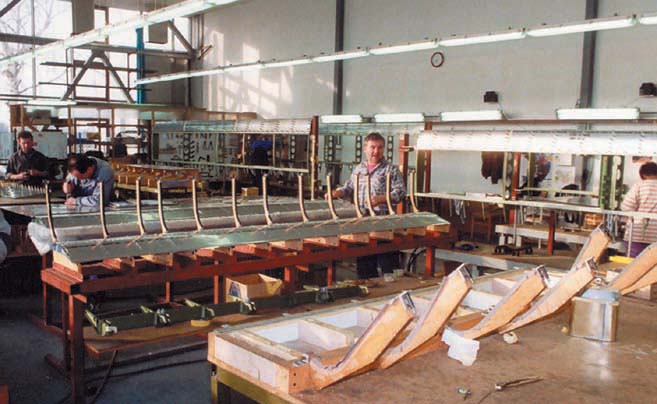
Czech Aircraft Works fabricates the wings, tail, and control surfaces for the Part 23-certified OMF Symphony.

Two of the aircraft built by Czech Aircraft Works, the Zenair 601 and 701, are fitted with the company's floats.

The Zenair 701 is fixed to Czech Aircraft Works' aluminum floats.

Chip Erwin, Czech Aircraft Works CEO, was pleased to show off his new downdraft paint booth.

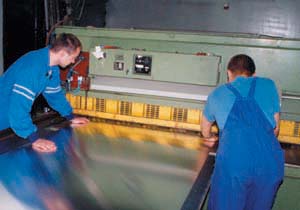



An American finds success building aircraft overseas. This is not a story about a Czech company. It’s about an American company in the Czech Republic, a distinction that makes this story different. For months we have been hearing and reading about sport pilot and light- sport aircraft (LSA). The FAA’s new rule is creating plenty of excitement for some very good reasons. That excitement is not confined to the U.S. Overseas manufacturers are eyeing the new rule as a way to enter the U.S. market. One of those in the best position to take advantage of the new rule is Czech Aircraft Works (CZAW). An American In Prague Chip Erwin hails from Wisconsin. Today, he is an American who owns a company in the Czech Republic. His CZAW has become one of that country’s largest aircraft producers. He accomplished all of this during the single decade when the Czech Republic regained its independence.
Copperstate’s 30th Anniversary

Copperstate celebrates its 30th anniversary at a promising new venue. That’s the dustiest place on Earth!” the pilot said upon returning from Phoenix Regional Airport in late 2001. John Kemmeries, a Phoenix-based ultralight entrepreneur, had sent the pilot to check out the proposed site for the Copperstate regional fly-in. The pilot’s reconnaissance report suggested a dry and dirty venue for the Arizona fly-in, but he had no way of knowing the event organizer’s vision. As I approached the area in BRS’s Cessna 172 Hawk XP for the 2002 fly-in, I found myself searching vainly for an airstrip among the desert’s uniform brown color. As the GPS led me along, I suddenly saw a large swatch of green dotted with colored tents. My uncertainty vanished; the site stood out like the proverbial sore thumb. Welcome to the new, improved Copperstate as created by thousands of volunteer man-hours and the support of a local land owner.
Blois Airshow
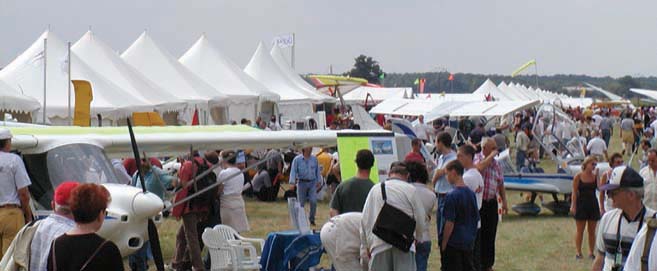
Large crowds at Blois, France, made more than 90 exhibitors happy. The choices in light aircraft were broad.

DynAero of Dijon, France, unveiled and flew its surprisingly roomy four-seat, carbon-fiber kit airplane. It cruises with a full load at 150 knots on only 100 hp.

The prototype Evolution from Dallach of Germany flew every day, retracting and deploying its Cessna 210-style gear system.

BMW and Mercedes are both offering powerplants to light aircraft. This sleek Chapelet trike built in France uses the BMW opposed-cylinder entry.

Loaded with options and ready to fly, the composite Junior from Poland costs $33,000 in Europe and weighs only 594 pounds empty.

The B&F Technik Polaris cruises and climbs fast. It proved to be a delight to fly.


This French light-airplane show Tops Anything in the U.S. The name of the French venue is a bit awkward for Americans, though it rolls off the French tongue fluidly. Blois—pronounced Blwah—is a superb airshow that should grab the interest of every light-airplane enthusiast. Light Airplanes Everywhere! I’ve been to Sun ’n Fun for more than 25 years and to Oshkosh nearly as many. I spend a lot of time in the ultralight area of each, and they’re big events, no question. But both take a second seat to Blois. Yes, believe it or not, the event 185 kilometers south of Paris last August is the largest of the ultralight airshows I’ve seen. With 90 exhibitors and more than 500 aircraft, most of which were flown to the event, Blois beats even Paradise City at the Lakeland, Florida, Sun ’n Fun fly-in. I’ve known of this 22-year-old show since the ’80s but attended for the first time last summer.
New Aircraft Arrive at Arlington


Washington-based North Wing Design released its Apache Sport this spring at Sun 'n Fun but subsequently improved its looks with this new pod fairing.

Mark Beierle has developed this tiny radial engine using eight cylinders, though he says it's still a work in process.

Designer Darryl Murphy followed a familiar pattern by fitting a larger engine to his JDM-8 that flew well with the Rotax 277.


Sport Flight Aviation is back and has reviewed its designs with CAD software. The company is now ready to start production.
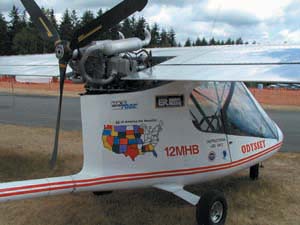

With 200-foot-tall trees and mountain peaks topped with snow throughout the year, Washington is a scenic place for an airshow. Despite a drought that caused the grass to crunch underfoot, light aviation looked alive and well at the EAA’s Arlington gathering for 2003. Local Boys Make Good One main attraction was the much-anticipated RV-10 four-place aircraft that drew big crowds. But a Washington-area group also revealed their efforts of past months. Sport Flight Aviation displayed in the ultralight area with the first of 50 kits in progress. Two completed Talons—the last of the old design—stood alongside a new Typhoon. The new closely resembles the old. Company owners Todd Thompson and Ron Osborne took pride in showing me extensive CAD-generated drawings printed after a lengthy effort to document the popular northwest design. Each of the men operates a non-aviation business. They teamed up to resuscitate a company left leaderless after the death of its founder, Roger Bitton.

